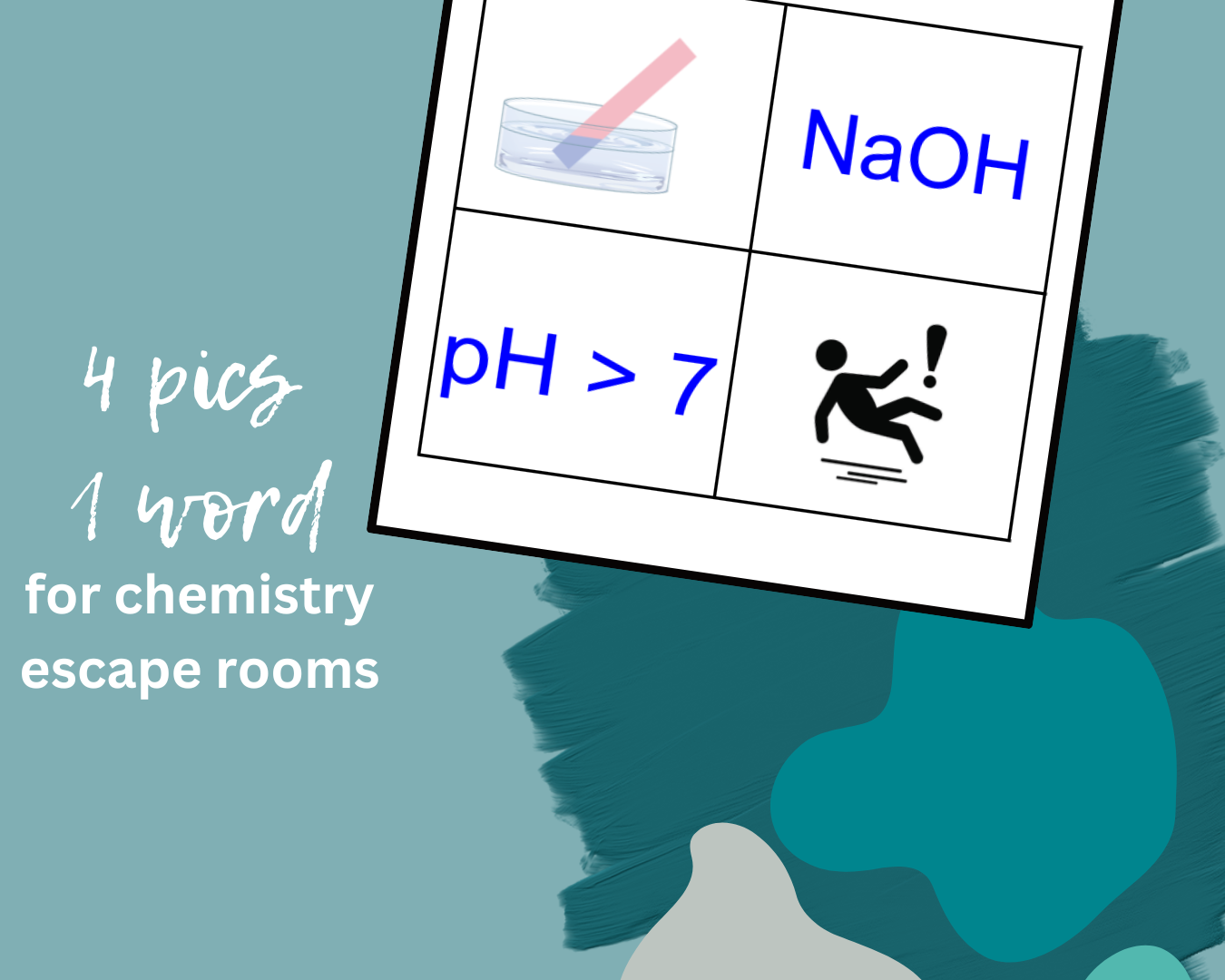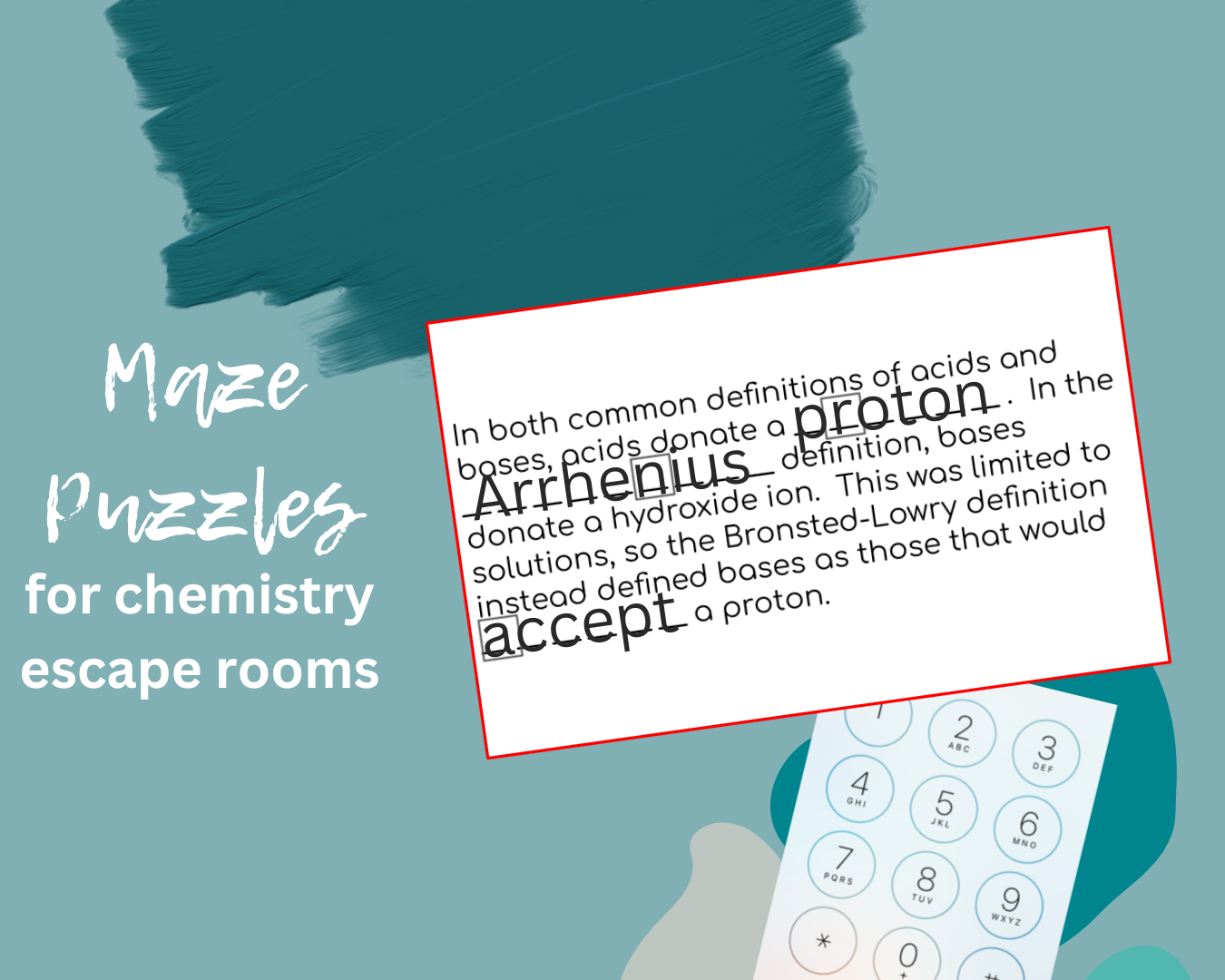6 More Chemistry Escape Room Puzzle Ideas
Disclaimer-Many of the links in this post are affiliate links. This means I will make a small commission if you purchase something using my links, but it is at no cost to you.
Do you use escape rooms in your chemistry classes? Have you always wanted to try escape rooms, but weren’t sure where to start generating puzzles and clues? If either of these is the case, this post is for you! In this post, I am going to mention of the puzzles and clues I have utilized in my high school chemistry escape rooms. These puzzles and clues are great for breakout boxes, and I have included 6 additional clue ideas in this post. If you missed the first 12 ideas, check those out here. These puzzles and clues are great for chemistry conceptual content. as well as mathematical chemistry content. If you’re interested in chemistry escape room puzzles and clues, read on for 6 MORE clue and puzzle ideas that you could implement with your chemistry breakouts.
Mazes.
Create a maze for students to follow. You can use this website to create a maze using text. Once students follow the path, they will need to interpret the message. For example, the maze pictured to the left prompts students to consider which side of the reaction is favored if K >> 1. The answer is “products,” and I use that to make a 4-letter word “prod” for a 4-letter word lock.
You could also have students read the message and then complete an additional action after they read the message.
4 pics 1 Word.
This clue is pretty straightforward. Find four images that relate to each other. Those four images should relate to one word. In my example to the right, I have four images that represent a base in acid-base chemistry. Therefore, the one word is “base,” which I can set a the code to a 4-letter word lock.
Multiple Choice Task Cards.
Provide students with a set of multiple choice questions on task cards. Students will read the questions and pick the best answer for the question. You can then have students count up the total number of “A,” “B",” “C,” and “D” responses. I prompt students to do this using a mirrored image that instructs students to “complete the cards and count the total number of A, B, C, and D answers.” If the students end up with 2 A, 3 B, 3C, and 2D, the code for a 4-digit number lock would then be “2332.” These are great for that chemistry content that is more conceptual and less about the math. Plus it allows for more multiple choice practice, which always seems to be needed.
Phone Clue.
An easy way to get a number lock is to use a phone to match letters to numbers. You can set up a statement in which students have to fill in the missing words. Inside those words, box certain letters and provide students with a printout of a phone keypad. Students would need to match the letter in the box to the number on the phone keypad. In my example to the right, the boxed letters include an “R”, and “N” and an “A.” The “R” matches to the number “7”, while “N” matches with “6” and “A” matches with “2.” This then would give a 3-digit number for a 3-digit number lock.
Vocab Match Wheels.
This one takes a little more set-up. You need two wheels. The first wheel should be a set of vocab terms. The second wheel would be the definitions of those words. I added arrows so that I could use this for a directional lock. I placed the term wheel (no arrows) on the left side of a piece of paper and the definitions (with arrows) on the right side. I found out after the first game that I needed to indicated which way was up, so I added a “top corner” to the board-ooops. You will need to attach the wheels to the paper so that they can freely rotate. I recommend mini brads, if you have more than one team differentiated by different colors, you can use these rainbow mini brads to match colors!
I provided students with a mirror image that prompted students to “start with amphiprotic and turn the term wheel clockwise.” This means they would turn the term wheel (no arrows) so that the word amphiprotic was in the middle. They would then turn the definition wheel to match with that term. As they do so, they will get an arrow in a certain direction, which would be the first direction for the directional lock. Then the students turn the term wheel (no arrows) clockwise to get to the next term. They then turn the definitions wheel (arrows) until they get a match and record the arrow that results. This continues until they get through all 8 terms. They then input the directions into a directional lock.
Use a lab activity as a clue.
My last clue for today is to throw in a lab activity as a clue! We are chemistry teachers after all! In the past, I have done this a couple of ways. In one breakout, I provided a sample of copper and a balance, along with a clue that instructed students to figure out how many moles were in the sample. This then could be used in a number lock.
I have also had a full on titration as part of a breakout before. The task was for students to determine the concentration of an unknown to within 10%. If they were within 10%, I would give them a key to unlock a key lock on their box. The students loved this as part of the breakout, as it was an authentic chemistry experience. 10/10 would do again.
Escape Room Puzzle Storage
In my classroom, I have 6 boxes for breakout/escape rooms, so that I can have 6 separate teams. Those 6 teams all have their own clues. I initially stored puzzles in those letter-sized manila envelopes. But the clasps would break and they just weren’t holding up well. So I have transitioned to these mesh zipper pouches. They are much more durable. You can even get them in different colors, which works great for my 6 teams (red, orange, yellow, green, blue, and purple).
Thanks for reading! I hope these puzzle and clue ideas spark some new ideas for escape room puzzles in your classroom. Check out the first 12 clue ideas here, along with escape room supplies you’ll need here. If you do not have time to make your own breakouts, check out my Escape Rooms available in my TPT store.
Affiliate Links.
Disclaimer-I make a small commission if you use these links to purchase an item at no cost to you.















